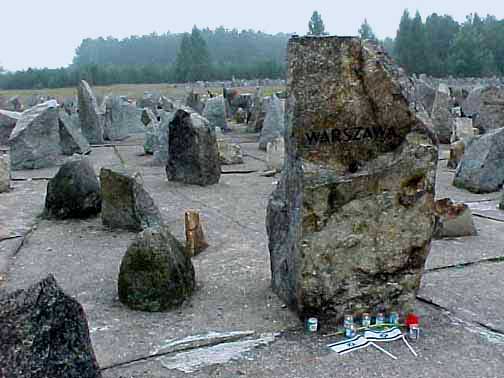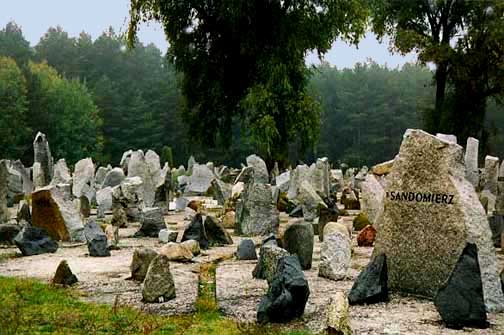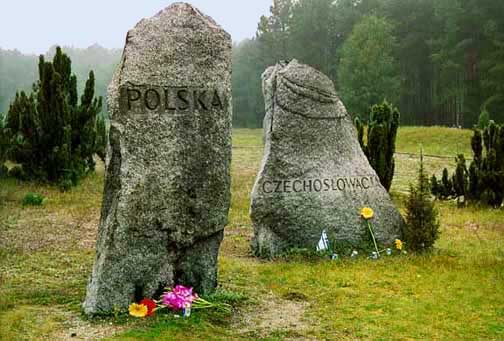Warsaw Stone at Treblinka Cemetery
 Symbolic grave stone
honors victims from Warszawa (Warsaw)
Symbolic grave stone
honors victims from Warszawa (Warsaw)
The largest stone in the symbolic cemetery
at Treblinka is the one for Warsaw, from where the largest number
of Jews were transported to the death camp. According to historian
Martin Gilbert, 265,000 Jews from Warsaw were deported to Treblinka.
The US Holocaust Memorial Museum puts the number from Warsaw
at 300,000. In 1940 the Jewish population of Warsaw and the surrounding
area, about 400,000 people, were first crowded into a walled
ghetto, then later sent to Treblinka and other camps. According
to my tour guide, there were around 4,000 Jews still living in
Warsaw in 1998, but only 500 of them were active in the Jewish
religion.
The photograph above shows the large
stone dedicated to the victims from Warszawa, the Polish name
for the city that Americans know as Warsaw. Note the two flags
of Israel and the small metal cans holding votive candles, left
by recent visitors. This stone is the first one you see, right
in front of the large memorial tombstone, shown on the previous
page.
The photo below shows the stone for the
city of Sandomierz which is in the section that is farthest from
the memorial tombstone. Note the many small stones that have
no names. They represent the many villages in Poland where all
Jewish life was extinguished in the Holocaust.
 Stone commemorating
victims from Sandomierz
Stone commemorating
victims from Sandomierz
At the bottom of the slope, where the
symbolic cemetery is located, are 10 large stones with the names
of all the countries from where the victims came. These countries
are Poland, Czechoslovakia, Germany, Austria, the Soviet Union,
Greece, Bulgaria, Yugoslavia, France, and Belgium. According
to Martin Gilbert in his book "Holocaust Journey,"
there were 13,000 Jews deported to Treblinka from the Greek provinces
of Macedonia and Thrace, which were then occupied by Bulgaria,
so their stone says "Bulgaria." Bulgaria was an ally
of Germany, but no Jews from that country were deported. There
is another stone at Treblinka for the 43,000 Jews from German-occupied
Greece.
The photo below shows a close-up of the
stones commemorating the Jewish victims from Poland and Czechoslovakia.
At the base of the stones, visitors have placed votive candles
in metal cans, fresh cut flowers and tiny flags of Israel. In
the background, you can see part of the road which leads to the
gravel pit, where there was a labor camp for Jews about a mile
away.
 Stones in honor of
victims from Poland and Czechoslovakia
Stones in honor of
victims from Poland and Czechoslovakia
This page was last updated in 2002
|